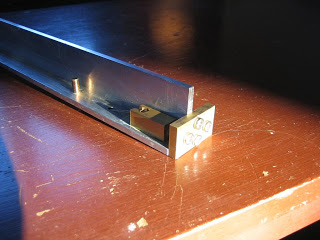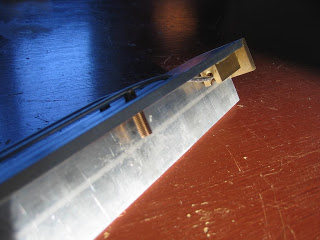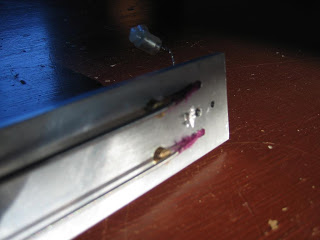Guitar
I've always wanted to try out my a particular form of tuners for headless guitars and basses. They work by having a scew pulling a brass block in which the ball end of the string is mounted. The main inspiration was Jeff Turpin's tuners; drawings and building guide for similar tuners can be seen at ScottyD's home made tuners. But since I have a T-beam, I can do away with the housings for the brass blocks that these designs use, and rather let them slide on the underside of the T-beam like this:

Two of the screws are for holding the brass plate on to the T-beam
The other two are for tuning.
I thought that 'd give it a try since I was going to cut the T-beam to length and I needed a bit of room for the tuners, so it was the last opportunity to try it out. It works very well - very smooth and precise, so I'll stick with them rather than reverting to the traditional tuners. I believe they'll be even better when I've mounted hex socket screws so I won't have to use a screwdriver to tune them. The holes where the strings go through the top flange could use some lengthening as well, which would make the strings' movement easier.

The picture shows the sharp turn, which the cable has to do going through the flange.
I'll stick with the new tuners rather than the standard bass tuners it had on earlier. That will also make it easier to make some good looking wood sides for the T-beam since I won't have to worry about making room for tuners that stick out. The brass blocks and string ends will be hidden within the body.
Earlier, while the traditional tuners were still on the bass, I was making and mounting a string tree that I needed for them. Unfortunately, the aluminium is so soft and sticky, that I broke off one of my threading taps inside the T-beam. Trying to get it out by cutting room around it with a dremel only made things worse. I'm afraid that I'll have to stray from my "form follows function" principle and make some sort of ornament to cover the damage, now that I don't need the string tree any longer.

Headstock-end with damage from string tree mounting attempt
(I later turned the T-beam around so this end was the bridge end back then).
On the image above, btw, you can see the strings going through the flange. They are secured on the underside by cable stops - the type used e.g. for brakes on mopeds.
Next step will be making the wooden sides plus some experimentation with Piezo pickup pre-amplifiers. And then back to tidy up the T-beam. Later, I am thinking about making a detachable body from steam bent plywood.
- Two-layer Aluminium Neck
Among the drawbacks of my old T-beam designs were the lack of a truss rod or similar system to control the bow of the neck. A way to help this - but still use stock aluminium beam for the guitar - could be having a neck in two layers - an upper flat beam,...
- New Tuner Design
In the previous post, I described my intention of creating a playable testbed for experiments with different pickups. It turned out to be nice to play, so I improved it with a strap horn and the acrylic body from my t-beam bass. As it turned out, it was...
- A Locking Nut That Didn't Work
Since I put the T-beam guitar on hold for a while, I bough a cheap Gibson SG copy for various experiments. One of the first things I wanted to try out was a tuning system, which uses a locking nut in combination with a Schaller 456 fine tuning bridge...
- A Different Tuner System For Headless Designs
The guitar I'm planning at the moment might be the first in a series. If it turns out well and the building process is fun (the planning sure is), I expect to build another one. And probably then another. And so on. If the guitar turns out sounding...
- Bridge And Tuners For The Headless Design
Having settled on a headless design, one of the next questions was which bridge and tuners to use. A small number of bridges with built-in tuners already exist, e.g. the ABM or the Steinberger. Unfortunately, they are all fairly expensive, and it was...
Guitar
New tuners
I've always wanted to try out my a particular form of tuners for headless guitars and basses. They work by having a scew pulling a brass block in which the ball end of the string is mounted. The main inspiration was Jeff Turpin's tuners; drawings and building guide for similar tuners can be seen at ScottyD's home made tuners. But since I have a T-beam, I can do away with the housings for the brass blocks that these designs use, and rather let them slide on the underside of the T-beam like this:
Two of the screws are for holding the brass plate on to the T-beam
The other two are for tuning.
I thought that 'd give it a try since I was going to cut the T-beam to length and I needed a bit of room for the tuners, so it was the last opportunity to try it out. It works very well - very smooth and precise, so I'll stick with them rather than reverting to the traditional tuners. I believe they'll be even better when I've mounted hex socket screws so I won't have to use a screwdriver to tune them. The holes where the strings go through the top flange could use some lengthening as well, which would make the strings' movement easier.
The picture shows the sharp turn, which the cable has to do going through the flange.
I'll stick with the new tuners rather than the standard bass tuners it had on earlier. That will also make it easier to make some good looking wood sides for the T-beam since I won't have to worry about making room for tuners that stick out. The brass blocks and string ends will be hidden within the body.
Earlier, while the traditional tuners were still on the bass, I was making and mounting a string tree that I needed for them. Unfortunately, the aluminium is so soft and sticky, that I broke off one of my threading taps inside the T-beam. Trying to get it out by cutting room around it with a dremel only made things worse. I'm afraid that I'll have to stray from my "form follows function" principle and make some sort of ornament to cover the damage, now that I don't need the string tree any longer.
Headstock-end with damage from string tree mounting attempt
(I later turned the T-beam around so this end was the bridge end back then).
On the image above, btw, you can see the strings going through the flange. They are secured on the underside by cable stops - the type used e.g. for brakes on mopeds.
Next step will be making the wooden sides plus some experimentation with Piezo pickup pre-amplifiers. And then back to tidy up the T-beam. Later, I am thinking about making a detachable body from steam bent plywood.
- Two-layer Aluminium Neck
Among the drawbacks of my old T-beam designs were the lack of a truss rod or similar system to control the bow of the neck. A way to help this - but still use stock aluminium beam for the guitar - could be having a neck in two layers - an upper flat beam,...
- New Tuner Design
In the previous post, I described my intention of creating a playable testbed for experiments with different pickups. It turned out to be nice to play, so I improved it with a strap horn and the acrylic body from my t-beam bass. As it turned out, it was...
- A Locking Nut That Didn't Work
Since I put the T-beam guitar on hold for a while, I bough a cheap Gibson SG copy for various experiments. One of the first things I wanted to try out was a tuning system, which uses a locking nut in combination with a Schaller 456 fine tuning bridge...
- A Different Tuner System For Headless Designs
The guitar I'm planning at the moment might be the first in a series. If it turns out well and the building process is fun (the planning sure is), I expect to build another one. And probably then another. And so on. If the guitar turns out sounding...
- Bridge And Tuners For The Headless Design
Having settled on a headless design, one of the next questions was which bridge and tuners to use. A small number of bridges with built-in tuners already exist, e.g. the ABM or the Steinberger. Unfortunately, they are all fairly expensive, and it was...
